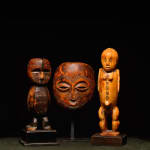Lega "Lukungu" Mask, DRC
4 3/8 x 4 in
Further images
-
(View a larger image of thumbnail 1
)

-
(View a larger image of thumbnail 2
)

-
(View a larger image of thumbnail 3
)

-
(View a larger image of thumbnail 4
)

-
(View a larger image of thumbnail 5
)

-
(View a larger image of thumbnail 6
)

-
(View a larger image of thumbnail 7
)

-
(View a larger image of thumbnail 8
)

-
(View a larger image of thumbnail 9
)

-
(View a larger image of thumbnail 10
)

-
(View a larger image of thumbnail 11
)

-
(View a larger image of thumbnail 12
)

The great significance of this work lies both in the rarity of its type and in the remarkable craftsmanship of the artist who created it. The scale and material - ivory - identify it as a Lukungu mask, the prerogative of Bwami initiates positioned within the highest level of the supreme rank, the lutumbo lwa kindi. This eminent ownership is compounded, as a factor of rarity, by the irregular possession of this emblem within the Lega clans.Their name, lukungu, refers to the skull. Owned on a conditional basis by each initiate, these ivory masks are considered "duplicates, souvenirs,proofs of identity, symbolic ties" uniting the kindi initiate to the deceased he replaced in the rank community. They symbolize "the continuity of a lineage of kindi initiates” (Biebuyck, Lega Culture Art. Initiation and Moral Philosophy among a Central African People, 1973, p. 211).Within a corpus generally marked by the minimalism of its sculpture, this work is distinctive for its superb intensity of the face, and its magnitude. Chevron lines delineate the contours of the "heart-shaped" face and emphasise the impact of the finely modelled features. Its scale and the care taken in its elaborate carving evoke very rare ivory masks that were "a little larger, and belonged to a preceptor (or leaders of rituals)" (ibid). According to field surveys conducted by Kellim Brown in Lega country, a "lukungu is ritually interpreted according to its formal qualities [...]; the tapered zigzag linear patterns on the forehead [...] identify the most important masks [...]; the medicinal sampling on the nose attesting to its ritual role " (« Crossing the Lega Ivory Spectrum » in Felix, White Gold, Black Hands, Ivory Sculpture in Congo, vol. 6, p. 64-66). Finally, the beauty of its deep patina, varying in brown and orange hues, attests to the frequency and longevity of its use, invariably preceded by the secret ibonga masengo ritual during which, by anointing it with pigmented oil, the strength of this sacred initiation object was revived.
L’insigne importance de cette œuvre tient à la fois de la rareté du type et de sa remarquable facture. Sa dimension et son matériau – l’ivoire - l’identifient à une masquette lukungu, prérogative des initiés du Bwami ayant atteint le plus haut échelon du grade suprême, les lutumbo lwa kindi. A cette appartenance restrictive s’ajoute, comme facteur de rareté, le fait que cet emblème n'était pas utilisé par tous les clans Lega. Leur nom, lukungu, désigne le crâne. Possédées à titre conditionnel par chaque initié, ces masquettes en ivoire sont considérées comme « des doubles, des souvenirs, des preuves d’identité, des liens symboliques » unissant l’initié kindi au défunt qu’il a remplacé dans la communauté de grade. Elles symbolisent ainsi “la continuité d’une lignée d’initiés kindi “ (Biebuyck, Lega Culture Art. Initiation and Moral Philosophy among a Central African People, 1973, p. 211).Au sein d’un corpus généralement caractérisé par le minimalisme de la sculpture, cette œuvre se distingue par la superbe intensité du visage, et par son ampleur. Les lignes en chevrons dessinant les contours de la face « en cœur » concentrent l’impact des traits finement modelés. Sa dimension et le soin porté à son élaboration évoquent les très rares masquettes en ivoire, « un peu plus grandes, appartenant à un précepteur (ou chef des rituels) » (idem). Selon les enquêtes de terrain menées par Kellim Brown en pays Lega, « lukungu est rituellement interprété en fonction de ses qualités formelles […] ; les motifs linéaires en zigzag tatoués sur le front […] identifient les masquettes les plus importantes […] ; les prélèvements médicinaux sur le nez témoignent de son rôle rituel » (« Crossing the Lega Ivory Spectrum » in Felix, White Gold, Black Hands, Ivory Sculpture in Congo, vol. 6, p. 64-66). Enfin, la beauté de sa patine profonde, jouant sur les teintes brunes et orangées, atteste la fréquence et la longévité de son usage, invariablement précédé du rite secret ibonga masengo au cours duquel, par onction d’huile pigmentée, la force de cet objet d’initiation sacré était ravivée.
De grote betekenis van dit werk ligt zowel in de zeldzaamheid van zijn type als in het opmerkelijke vakmanschap van de kunstenaar die het heeft gecreëerd. De verhoudingen en het materiaal - ivoor - identificeren het als een Lukungu-masker, het voorrecht van Bwami-geïnitieerden gepositioneerd binnen het hoogste niveau van de hoogste rang, de lutumbo lwa kindi. De zeldzaamheid wordt versterkt, door het beperkt aantal gekende gelijkaardige maskers binnen de Lega-clans. Hun naam, lukungu, verwijst naar de schedel. Eigendom op voorwaardelijke basis van elke initiatiefnemer, worden deze ivoren maskers beschouwd als "duplicaten, souvenirs, bewijzen van identiteit, symbolische banden" die de kindi-geïnitieerden verenigen met de overledene die hij in de ranggemeenschap heeft vervangen. Ze symboliseren "de continuïteit van een lijn van kindi-geïnitieerden" (Biebuyck, Lega Culture Art. Initiation and Moral Philosophy among a Central African People, 1973, p. 211). Binnen een corpus dat over het algemeen wordt gekenmerkt door minimalisme, is dit werk onderscheidend door zijn uitstekende intensiteit van het gezicht en zijn omvang. Chevronlijnen omlijnen de contouren van het "hartvormige" gezicht en benadrukken de impact van de fijn gemodelleerde kenmerken. De schaal ervan en de zorg die is besteed aan het uitgebreide snijwerk verwijst naar de zeer zeldzame ivoren maskers die "een beetje groter waren en toebehoorden aan een leraar (of leiders van rituelen)" (ibid). Volgens veldonderzoeken uitgevoerd door Kellim Brown in Lega-land, wordt een "lukungu ritueel geïnterpreteerd volgens zijn formele kwaliteiten [...]; de taps toelopende zigzaglijnen op het voorhoofd [...] identificeren de belangrijkste maskers [...]; het medicijnmonster op de neus getuigt van zijn rituele rol" (" Crossing the Lega Ivory Spectrum "in Felix, White Gold, Black Hands, Ivory Sculpture in Congo, vol. 6, p. 64-66). Tot slot getuigt de schoonheid van zijn diepe patina, variërend in bruine en oranje tinten, van de frequentie en de duurzaamheid van het gebruik ervan, steevast voorafgegaan door het geheime ibonga masengo-ritueel waarbij, door het zalven met gepigmenteerde olie, de kracht van dit heilige inwijdingsobject werd vernieuwd.
Provenance
Jean-Willy Mestach (1926-2014), BruxellesAaron Furman, New York, acquired in 1962
Collection Howard et Saretta Barnet, acquired en 1973
Belgian Private Collection
Join our mailing list
* denotes required fields
We will process the personal data you have supplied in accordance with our privacy policy (available on request). You can unsubscribe or change your preferences at any time by clicking the link in our emails.











